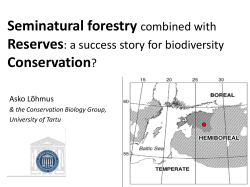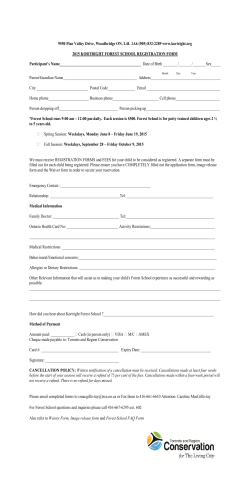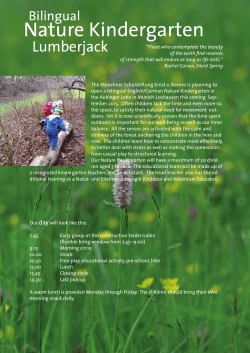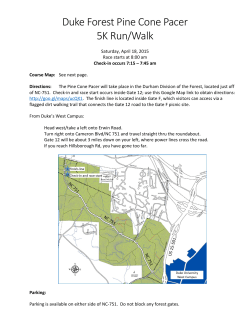
Ancient forests â modern threats: challenges for biodiversity
Ancient forests – modern threats: challenges for biodiversity management in forest reserves Jörg Brunet – Swedish Univ. Agricultural Sciences, Alnarp Contents • Temperate forest reserves in southern Sweden • Conservation goals in forest reserves • Emerging threats to forest biodiversity The Dalby Söderskog case • Some lessons learnt Forest reserves in Sweden • Increasing areas (currently ca 175 000 ha in the temperate part of the country) • Focus on conservation of temperate broadleaved forests in southern Sweden • Many protected temperate forests regenerated under semi-open conditions and low or absent ungulate browsing during the 1800s • High share of light-demanding long-lived tree species: oak, ash, pine Conservation goals for forest reserves • Maintain desired successional cycle (or stage) and its biodiversity • Full life cycles of native tree species can be completed • Natural regeneration of these tree species • Emerging threats may put these goals at risk in many reserves Dalby Söderskog as a case for emerging threats (and opportunities) • “Skånes Suserup skov” • 36 ha forest reserve since 1918 • Mixed oak-beechelm-ash forest • 5 tree taxations 1909-2012 • 6 herb layer surveys 1935-2013 Old and emerging threats for biodiversity in Dalby Söderskog Earlier: Less disturbance after protection --> canopy closure --> decreased plant diversity and lack of oak regeneration Now: Multiple emerging threats • 1980s Dutch elm disease • 1990s Invaded by the slug Arion vulgaris (lusitanicus) • 2000s Ash dieback • 2010s Invaded by wild boar Sus scrofa Earlier: Crown encroachment and increased mortality of “pasture” oaks Result: Old-growth forest until 1980s Ulmus - Fraxinus - Mercurialis perennis type Now: Canopy opening by new diseases Hymenoscyphus pseudoalbidus: Ash dieback Ophiostoma novo-ulmi: Dutch elm disease Phytophthora plurivora & P. cambivora affect old beech trees Ash dieback Dutch elm disease The future: A new oak generation ? Dalby Söderskog with live oaks (green dots), dead oaks (crosses), and oak saplings 1.3-5m m height (red dots) in 2012 A successor for the fallen veteran oak? Taking the opportunity… Oak & hazel Maple (& lime) Open glades and flowering shrubs increase Euonymus europaeus Viburnum opulus Crataegus spp. Rosa spp. Alternative successional pathways in response to tree dieback? • Source populations needed • Most broadleaves sensitive to ungulate browsing • No diverse natural regeneration in much of southern Sweden due to heavy browsing pressure Emerging threats affect all vegetation layers: Slug herbivory causing decline of the dominant forest herb: Mercurialis perennis Wild boar invasion causing decline of the vernal wildflower vegetation 2009 2012 Gradual decline of springflowers by yearly rooting Plot 18 in spring 2010 Plot 18 in spring 2013 But: Wild boar may eat the slugs! Exclosures needed to study effects on tree regeneration Conclusions • Globalization of plant diseases and pests leads to novel forest successions in many reserves • Loss of old-growth structures and associated biodiversity (e.g. epiphytes) • Gain of open-habitat structures and regeneration opportunities for valuable light demanding trees • Herbivore control needed to enable natural regeneration of remaining broadleaf species and pine • Many reserves with minimum intervention or traditional management may need active restoration measures Thank you Acknowledgements: Yulia Bukina, Per-Ola Hedwall, Emma Holmström, Goddert von Oheimb, Emmelie Wahlgren
© Copyright 2025













